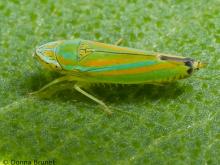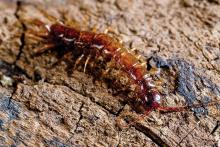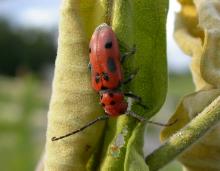Land Invertebrates
Media

Species Types
Scientific Name
More than 3,000 species in North America north of Mexico
Description
The leafhoppers are a large and diverse family of sap-sucking, hopping insects. You can distinguish them from similar groups of hoppers by the hind legs, which have at least one row of small spines on the hind tibiae (“shins”).
Media

Species Types
Scientific Name
More than 900 species in North America north of Mexico
Description
Millipedes, which have two pairs of legs per body segment, are harmless detritus-eaters, move slowly, and curl up defensively when harassed.
Media

Species Types
Scientific Name
Hundreds of species in North America north of Mexico
Description
Centipedes are familiar to anyone who has overturned rocks and logs, sifted through leaf litter, or dug in the soil. Learn more about Missouri's members of class Chilopoda.
Media

Species Types
Scientific Name
Approx. 150 species of land snails and slugs in Missouri
Description
Most people know land snails and slugs when they see these interesting animals. Missouri has about 150 species in 25 families.
Media

Species Types
Scientific Name
Nearly 200 species in North America north of Mexico
Description
Assassin bugs are usually black or brown, with an elongated head bearing a single, clawlike tube used for piercing and injecting venom into their prey. They are common in Missouri.
Media

Species Types
Scientific Name
Arilus cristatus
Description
The wheel bug is a large gray or brown insect that carries something interesting on its back: Is it a cog, or a wheel, or a circular saw blade?
Media

Species Types
Scientific Name
More than 5,000 species in North America
Description
Most ichneumon wasps are harmless, although the long ovipositor of the female is intimidating. Their larvae live as parasites inside caterpillars and other larval insects.
Media

Species Types
Scientific Name
About 1,000 species in North America north of Mexico
Description
Longhorned beetles are elongated and cylindrical, with antennae that are at least half the length of the body — sometimes much longer. The larvae are grubs that bore in wood or other plants. Some are serious pests.
Media

Species Types
Scientific Name
8 tribes, with about 23 genera, in North America north of Mexico
Description
Millipedes in family Xystodesmidae often have bright colors that serve as a warning to potential predators that they may secrete foul or toxic substances.
Media

Species Types
Scientific Name
About 1,700 species in North America north of Mexico
Description
The scarab beetle family is very large, with breathtaking variety — and often great beauty. Many scarabs are large and colorful.
See Also



Media

Species Types
Scientific Name
Cisseps fulvicollis
Description
The yellow-collared scape moth is more often “orange-collared.” And whether you think it looks more like a firefly or a wasp, it’s still a moth!
Media

Species Types
Scientific Name
Nearly 150 species in North America north of Mexico
Description
Slim, delicate plume moths are instantly recognizable by their T-shaped silhouette, long legs, and muted shades of tan and brown. It can be hard to separate the various species.
Media

Species Types
Scientific Name
Pyrrharctia isabella
Description
Not many people know the adult Isabella tiger moth when they see one, but we’re all acquainted with its caterpillar, the woolly worm, or woolly bear.
About Land Invertebrates in Missouri
Invertebrates are animals without backbones, including earthworms, slugs, snails, and arthropods. Arthropods—invertebrates with “jointed legs” — are a group of invertebrates that includes crayfish, shrimp, millipedes, centipedes, mites, spiders, and insects. There may be as many as 10 million species of insects alive on earth today, and they probably constitute more than 90 percent all animal species.





















